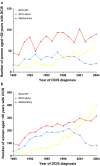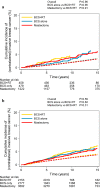Subsequent risk of ipsilateral and contralateral invasive breast cancer after treatment for ductal carcinoma in situ: incidence and the effect of radiotherapy in a population-based cohort of 10,090 women
- PMID: 27624164
- PMCID: PMC5021731
- DOI: 10.1007/s10549-016-3973-y
Subsequent risk of ipsilateral and contralateral invasive breast cancer after treatment for ductal carcinoma in situ: incidence and the effect of radiotherapy in a population-based cohort of 10,090 women
Erratum in
-
Erratum to: Subsequent risk of ipsilateral and contralateral invasive breast cancer after treatment for ductal carcinoma in situ: incidence and the effect of radiotherapy in a population-based cohort of 10,090 women.Breast Cancer Res Treat. 2017 Jan;161(2):389-390. doi: 10.1007/s10549-016-4060-0. Breast Cancer Res Treat. 2017. PMID: 27878644 Free PMC article. No abstract available.
Abstract
Purpose: To assess the effect of different treatment strategies on the risk of subsequent invasive breast cancer (IBC) in women diagnosed with ductal carcinoma in situ (DCIS).
Methods: Up to 15-year cumulative incidences of ipsilateral IBC (iIBC) and contralateral IBC (cIBC) were assessed among a population-based cohort of 10,090 women treated for DCIS in the Netherlands between 1989 and 2004. Multivariable Cox regression analyses were used to evaluate associations of treatment with iIBC risk.
Results: Fifteen years after DCIS diagnosis, cumulative incidence of iIBC was 1.9 % after mastectomy, 8.8 % after BCS+RT, and 15.4 % after BCS alone. Patients treated with BCS alone had a higher iIBC risk than those treated with BCS+RT during the first 5 years after treatment. This difference was less pronounced for patients <50 years [hazard ratio (HR) 2.11, 95 % confidence interval (CI) 1.35-3.29 for women <50, and HR 4.44, 95 % CI 3.11-6.36 for women ≥50, P interaction < 0.0001]. Beyond 5 years of follow-up, iIBC risk did not differ between patients treated with BCS+RT or BCS alone for women <50. Cumulative incidence of cIBC at 15 years was 6.4 %, compared to 3.4 % in the general population.
Conclusions: We report an interaction of treatment with age and follow-up period on iIBC risk, indicating that the benefit of RT seems to be smaller among younger women, and stressing the importance of clinical studies with long follow-up. Finally, the low cIBC risk does not justify contralateral prophylactic mastectomies for many women with unilateral DCIS.
Keywords: Ductal carcinoma in situ; Invasive breast cancer; Population-based cohort study; Radiotherapy; Surgery.
Conflict of interest statement
LE Elshof, M Schaapveld, MK Schmidt, EJ Rutgers, FE van Leeuwen, and J Wesseling declare that they have no conflict of interest. Ethical approval All procedures performed in studies involving human participants were in accordance with the ethical standards of the institutional and/or national research committee and with the 1964 Helsinki Declaration and its later amendments or comparable ethical standards. Informed consent The study was approved by the review boards of the Netherlands Cancer Regsitry and PALGA, the nationwide histopathology and cytopathology data network and archive. The study used only unidentifiable patient information, and no informed consent was required. Reasearch involving human and animal rights This article does not contain any studies with animals performed by any of the authors.
Figures




References
MeSH terms
LinkOut - more resources
Full Text Sources
Other Literature Sources
Medical

